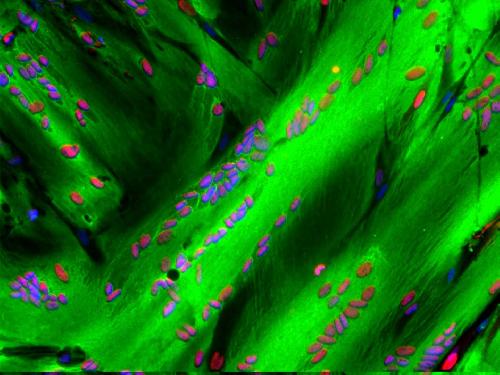La Jolla, Calif., Feb. 9, 2016 -- Researchers at Sanford Burnham Prebys Medical Research Institute (SBP) have conclusively identified the protein complex that controls the genes needed to repair skeletal muscle. The discovery clears up deep-rooted conflicting data and will now help streamline efforts towards boosting stem cell-mediated muscle regeneration. Such strategies could treat muscle degenerative diseases such as muscular dystrophies, and those associated with aging and cancer.
The research, published today in eLife, describes the essential role of a TBP-containing TFIID-protein complex in activating genes that regenerate muscle tissue, and shows that an alternative protein called TBP2 is not involved in this task in adult muscles.
"Our discovery clarifies the identity of the 'molecular switches' that control the activation of muscle genes in muscle stem cells (MuSCs)," said Barbora Malecova, Ph.D., postdoctoral fellow in the laboratory of Pier Lorenzo Puri, M.D., professor in the Development, Aging and Regeneration Program at SBP, and first author of the article. "Understanding what drives muscle gene expression gives us insights into molecular targets for regenerative medicine-based interventions (drugs) to treat muscle degenerative disorders."
 The image shows human differentiated myotubes expressing MyoD (nuclear staining -- red; nuclei are also counterstained with DAPI - blue) and MyHC (cytoplasmic staining -- green). Credit: Alessandra Dall'Agnese
The image shows human differentiated myotubes expressing MyoD (nuclear staining -- red; nuclei are also counterstained with DAPI - blue) and MyHC (cytoplasmic staining -- green). Credit: Alessandra Dall'Agnese
MuSCs are adult stem cells present in skeletal muscle tissue that become activated in response to muscle injury to regenerate damaged muscle. In healthy skeletal muscle, MuSCs promote self-healing to repair muscle from normal wear and tear. But in disease conditions like muscular dystrophies, genetic mutations lead to the loss of key structural proteins of muscle cells, which results in cell dysfunction. Cells with these mutations can't sustain the chronic regeneration pressure imposed by the disease, eventually resulting in progressive muscle weakness and death.
Transcription factors regulate the differentiation or "programming" of MuSCs into mature muscle cells. Targeting transcription factors to activate muscle gene expression is an emerging, promising approach to generate new contractile fibers that counterbalance muscle loss.
"Previous reports had led researchers to believe that a transcription factor called TRF3 (also called TBP2) was absolutely required to activate muscle genes," said Malecova. "Our new study shows that it's actually a closely related complex called TFIID-TPB that's key to regenerating muscle. In fact, we show that the TBP2 protein is not even expressed in muscle cells."
The initial hint that TBP2 was not required came from collaborative studies with Laszlo Tora, Ph.D., at the Institute of Genetics and Molecular and Cell Biology (IGBMC) in Strasbourg showing that injured mice without the TBP2 gene could still regenerate muscle. Further investigation showed that although present in minimal amounts, TFIID-TBP was the essential complex for muscle gene expression.
"This is an important finding as it resolves a long-standing issue and will prevent researchers from continuing down a path of study unlikely to yield advances in the field," said Puri, senior author of the paper. "Defining the components of the transcription complex that controls the formation of skeletal muscle may help find new treatment options to improve the lives of patients with muscle degenerative disorders."
Puri's lab is dedicated to finding effective treatment for muscular dystrophies and is currently investigating the efficacy of epigenetic drugs that promote compensatory regeneration, while preventing fibrosis and fat deposition in dystrophic muscles.
source: Sanford-Burnham Prebys Medical Discover Institute